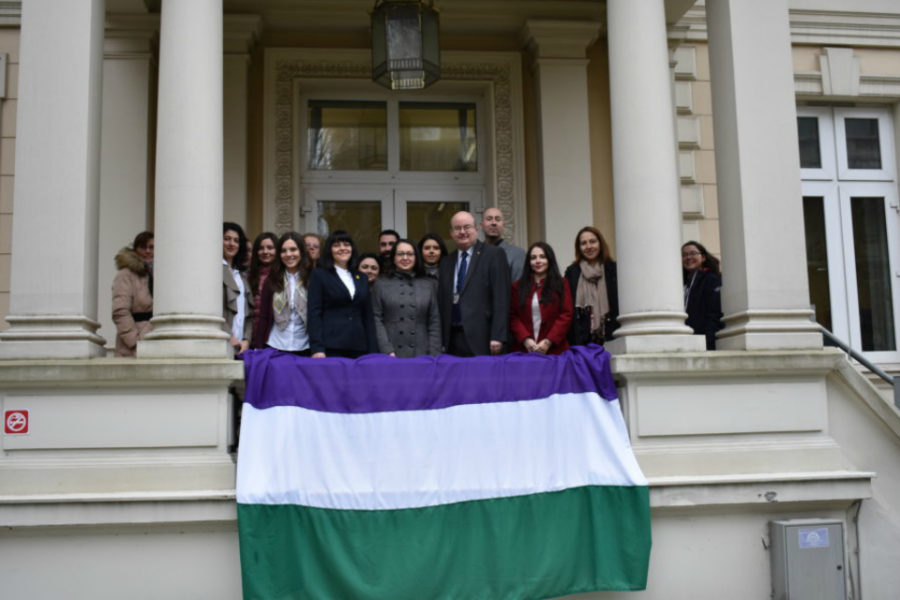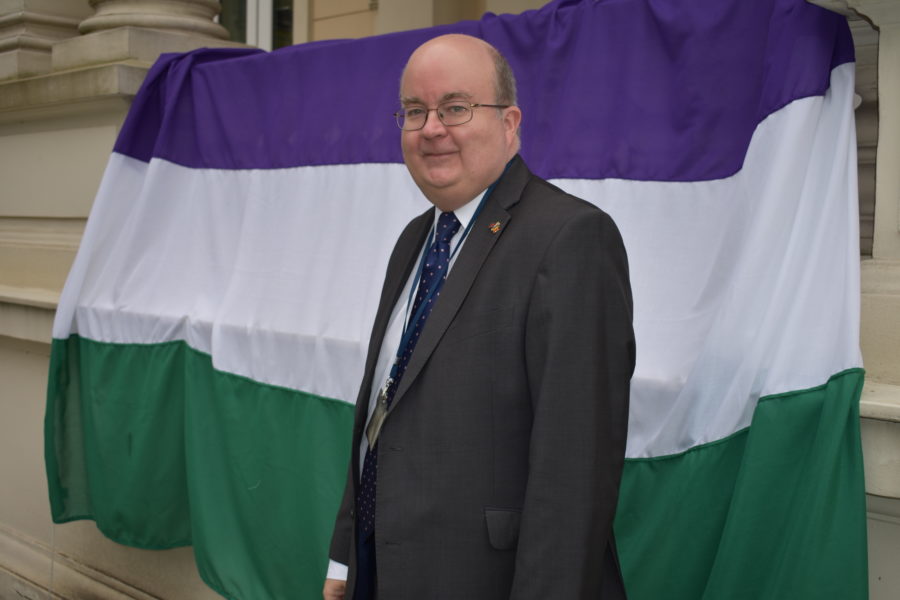8th February 2018
100 Years of Votes for Women

The staff of the British embassy in Bucharest gathered this week beside a large flag with three horizontal stripes: purple, white and green. What was this about?
One hundred years ago this week Royal Assent was received for the 1918 Representation of the People Act, an important milestone in women’s suffrage in Britain and one whose timing reflected the essential role of British women during the First World War and sacrifices they made. The Act extended the suffrage to women for the first time, though only to some women: those over the age of 30, with additional marital status, property and educational restrictions. Suffrage was extended at the same time to all men over the age of 21, without qualification. It would be another ten years before women and men in the UK were to receive full equality of voting rights.
Nonetheless, the Representation of the People Act was a major step forward, and there was to be a further important piece of legislation in 1918, the Parliament (Qualification of Women) Act, which allowed women to stand for election to parliament for the first time.
The passing of these two Acts also reflected the tireless campaigning of the many suffragette organisations, among them Emmeline Pankhurst’s Women’s Social and Political Union, whose banner was the flag beside which we were standing. The three bands of Green, White and Violet stood, using the first letters of the respective colours, for Give Women Votes. Other suffragette organisations adopted different colours; thus the banner of the Women’s Freedom League was green, yellow and white. But the use of Emmeline Pankhurst’s banner today serves to recall and celebrate the achievements of Britain’s suffragettes and suffragists as a whole.
The first woman to take her seat in the House of Commons was Nancy Astor, in 1919. An American divorcee, she met her second husband, Waldorf Astor, also US born, on a transatlantic voyage. Waldorf had been a good friend of Queen Marie of Romania, playing an important role in encouraging her to escape the strictures of King Carol’s court, to learn Romanian and to get to know the Romanian people, advice which was to prove a significant factor in helping Marie achieve her subsequent popularity. This link with Romania gives me the excuse to say something of Nancy Astor’s remarkable political career. She became the Conservative Member of Parliament for the port constituency of Plymouth Sutton, in a by-election occasioned by her husband’s elevation to the House of Lords. With an aristocratic style, and no background with the women’s suffrage movement, she was denounced as “out of touch” by the first woman actually elected to the House of Commons, Constance Markievicz, who had not taken up her seat the year before, in accordance with the policy of her party, Sinn Fein. One story, I have no idea if apocryphal or not, has it that while canvassing in Plymouth Nancy Astor was escorted by a naval officer. At one house, she was greeted by a small girl who told her that her mother had said “if a lady comes with a sailor they are to use the upstairs room and leave ten bob.”
She served her constituency until her retirement in 1945. She was noted for campaigning against the ills of alcohol: “Lady Astor’s Bill” raised the legal age for drinking alcohol in a public house from 14 to 18. But she also promoted early childhood education, and better treatment for young offenders. She is perhaps best remembered today for some famously barbed exchanges with Churchill: “If you were my husband, I’d poison your tea.” “Madam, if you were my wife, I’d drink it.”
Her later parliamentary career was unfortunately surrounded in controversy. A strong anti-communist, she was close to circles supportive of appeasement with Hitler, and she was prone to both anti-Semitic and anti-Catholic comments. But as a pioneering female politician she rightly deserved a place among the group of remarkable Romanian and British women around whom we organised an exhibition at the National Museum of Art in Bucharest in 2015.
The embassy team standing beside the suffrage flag is a mark then of celebration for the achievements of the suffrage movement and the passing of key legislation one hundred years ago. But it also marks a recognition that the journey of women’s political participation is an unfinished one. The percentage of women in the House of Commons is now 32%, a record high but still well below the 50% that one might expect with full gender equality of political participation. In Romania, women first had the opportunity to vote in local elections in 1929, though the right to vote was restricted on various grounds, including ones related to education, employment and marital status. Only one in five members of the Romanian Chamber of Deputies is female; the figure for the Senate is lower still, at just 14%.

The suffrage flag will be embarking on a journey around the eleven Embassies which comprise our Central European Network, stretching from Poland to Bulgaria, as part of a wider suffrage flag relay taking in our diplomatic missions around the world. This journey will be both one of celebration for the achievements secured one hundred years ago and of our determination to support the continuation around the world of progress along the road to full women’s political participation.